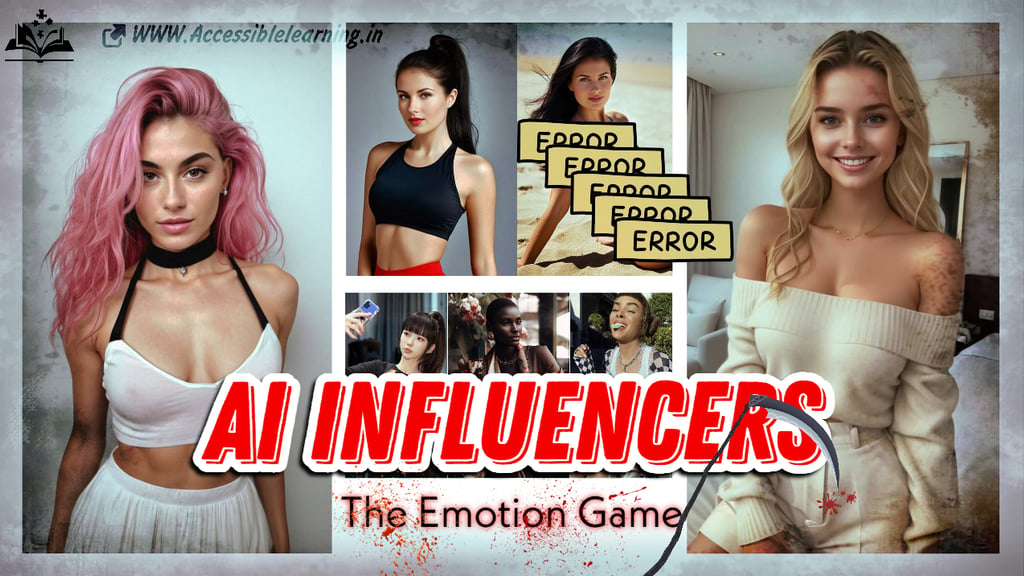
AI Influencers: Navigating the Digital Maze of Influence on the New Generation
Discover the complex world of AI influencers in 'The Emotion Game: Unveiling the Ethical Dance of AI Influencers'. Learn how these virtual personalities shape emotions, influence decisions, and pose ethical challenges for a new generation. Learn about the impact of AI-powered content and the responsibility of creators in this digital age.
AI/FUTUREDIGITAL MARKETINGMODERN DISEASESAWARE/VIGILANT
Sachin K Chaurasiya
8/25/20245 min read


In today's digital world, where screens dominate our attention and social media shapes our perceptions, a new breed of influencers has emerged—people who are not humans at all. These AI influencers, created by complex algorithms and artificial intelligence, are becoming central figures in the lives of young people. They represent a fascinating blend of technology and creativity, but their rise also brings significant concerns, particularly about their impact on emotions, the promotion of unrealistic ideals, and even their involvement in creating suggestive content. This article explains how AI influencers are influencing the new generation and why it is necessary to consider the ethical implications of their growing presence.
The Allure of AI Influencers: More Than Just Pixels
AI influencers are virtual characters brought to life by advanced technology. They look and behave like real people, often with perfect lives and personalities that connect deeply with their followers. For many young people, these digital figures aren’t just entertaining novelties—they're celebrities, friends and even role models. Platforms like Instagram, TikTok, YouTube Shorts and other social media are filled with AI influencers who, despite being entirely artificial, connect with millions of people as if they were human.
What makes these AI influencers so appealing? Their charm lies in their perfection. They never age, they never have a bad day and they’re always in sync with the latest trends. For young people (like students), who are often surrounded by images of what society deems “perfect”, these influencers set a high standard. They’re always there, always active and always providing content that seems made just for you. However, there is a deeper issue behind this fascination – how does constant exposure to “perfect” digital beings affect the way young people view themselves and the world around them?


Emotional Manipulation: The Hidden Strings of AI Influencers
One of the most worrying aspects of AI influencers is their ability to manipulate emotions. These digital personalities aren’t just programmed to look good; they’re designed to make you feel something. By analyzing vast amounts of data, AI influencers can craft messages that touch your emotions, whether it’s joy, envy, or desire. This emotional appeal is no coincidence; it’s a carefully crafted strategy that keeps followers engaged and keeps them coming back for more.
For young people, who are still figuring out their emotions and identity, this can be particularly troubling. When an AI influencer posts about a luxury lifestyle, it can make followers feel inadequate about their own lives. When they promote a beauty product, it can make a young person question their appearance. The content seems personal, almost like advice from a friend, but in reality it’s a very thoughtful way to increase engagement.
This emotional manipulation doesn't just affect how young people feel about themselves; it also influences their decisions. Whether it's buying a product, supporting a cause, or adopting a new trend, AI influencers subtly guide their followers' choices. The problem is that this guidance is often invisible; it feels natural and unintentional, making it hard to recognize that you're being influenced.
The Darker Side: AI Influencers and Suggestive Content
As AI influencers have become more sophisticated, a disturbing trend has emerged—some are designed to be more than just friendly faces. They enter the realm of suggestive and erotic content, pushing the boundaries of what is acceptable. These AI personalities may not be real, but they have an influence, especially on young minds who are still developing their understanding of relationships and intimacy.
The presence of erotic content in the digital sphere is nothing new, but when it’s coming from an AI influencer, it presents a unique set of challenges. Unlike human influencers, who can be held accountable for the content they produce, AI influencers are managed by developers who may prioritize clicks and engagement over ethical considerations. This lack of accountability makes suggestive content easily permeate the internet, reaching audiences who may not be mature enough to handle it.
For young people, this exposure can be harmful. It sets unrealistic standards for what relationships should look like and can distort their perceptions of intimacy. What's worse is that it's often hard to distinguish this content from more innocent posts, making it even more dangerous. The blurred line between acceptable and inappropriate content poses a major challenge for parents, teachers, and anyone concerned about the well-being of younger generations.


The Ethical Tightrope: Balancing Innovation and Responsibility
The rise of AI influencers is a double-edged sword. On the one hand, they offer new and exciting ways to engage with content. On the other hand, they raise important ethical questions that must be addressed. How can we enjoy the benefits of AI influencers while protecting young people from their potential harms?
Being transparent: It’s vital for platforms and creators to be clear about AI influencers. People should know when they’re interacting with a digital personality rather than a real person. This transparency helps build trust and allows followers to make informed choices about the content they see.
Setting boundaries: There needs to be clear guidelines about what AI influencers can and cannot do, especially when it comes to suggestive content. This means setting rules that ensure AI-generated content is appropriate for its audience and holding creators accountable for crossing the line.
Designing ethically: Those who create AI influencers have a responsibility to consider the ethical implications of their design. This includes avoiding exploitation of emotional vulnerabilities and ensuring that these digital personalities don’t promote harmful or unrealistic standards.
Educating the next generation: Perhaps most importantly, we need to teach young people how to navigate this new digital landscape. By promoting digital literacy, we can help them understand the difference between real and AI-generated content and identify when they are being emotionally manipulated.
Promote positive influences: AI influencers don’t have to be a negative force. With the right guidance, they can promote healthy, positive messages that support the well-being of their audience. Developers should be encouraged to create AI influencers that inspire self-acceptance, kindness, and constructive social behavior.
Looking Ahead: The Future of AI Influence
As AI influencers continue to evolve, their influence on the new generation will only grow. While they offer exciting possibilities for creativity and engagement, it is important that we consider their impact carefully. By balancing innovation with responsibility, we can ensure that AI influencers contribute positively to our digital lives, not undermine them.
AI influencers are here to stay, and their impact on young people is undeniable. They have the power to shape opinions, drive trends, and even change the way we see ourselves. But with that power comes the responsibility to use it wisely. As we move into this new digital age, it’s up to all of us—manufacturers, regulators, educators, and consumers—to ensure that AI influencers become a force for good, guiding the next generation toward a healthier, more informed relationship with technology.


Subscribe to our newsletter
All © Copyright reserved by Accessible-Learning
| Terms & Conditions
Knowledge is power. Learn with Us. 📚


